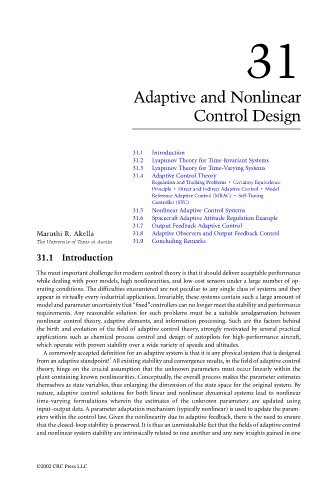Page 938 - The Mechatronics Handbook
P. 938
31
Adaptive and Nonlinear
Control Design
31.1 Introduction
31.2 Lyapunov Theory for Time-Invariant Systems
31.3 Lyapunov Theory for Time-Varying Systems
31.4 Adaptive Control Theory
Regulation and Tracking Problems • Certainty Equivalence
Principle • Direct and Indirect Adaptive Control • Model
Reference Adaptive Control (MRAC) • Self-Tuning
Controller (STC)
31.5 Nonlinear Adaptive Control Systems
31.6 Spacecraft Adaptive Attitude Regulation Example
31.7 Output Feedback Adaptive Control
Maruthi R. Akella 31.8 Adaptive Observers and Output Feedback Control
The University of Texas at Austin 31.9 Concluding Remarks
31.1 Introduction
The most important challenge for modern control theory is that it should deliver acceptable performance
while dealing with poor models, high nonlinearities, and low-cost sensors under a large number of op-
erating conditions. The difficulties encountered are not peculiar to any single class of systems and they
appear in virtually every industrial application. Invariably, these systems contain such a large amount of
model and parameter uncertainty that “fixed”controllers can no longer meet the stability and performance
requirements. Any reasonable solution for such problems must be a suitable amalgamation between
nonlinear control theory, adaptive elements, and information processing. Such are the factors behind
the birth and evolution of the field of adaptive control theory, strongly motivated by several practical
applications such as chemical process control and design of autopilots for high-performance aircraft,
which operate with proven stability over a wide variety of speeds and altitudes.
A commonly accepted definition for an adaptive system is that it is any physical system that is designed
1
from an adaptive standpoint! All existing stability and convergence results, in the field of adaptive control
theory, hinge on the crucial assumption that the unknown parameters must occur linearly within the
plant containing known nonlinearities. Conceptually, the overall process makes the parameter estimates
themselves as state variables, thus enlarging the dimension of the state space for the original system. By
nature, adaptive control solutions for both linear and nonlinear dynamical systems lead to nonlinear
time-varying formulations wherein the estimates of the unknown parameters are updated using
input–output data. A parameter adaptation mechanism (typically nonlinear) is used to update the param-
eters within the control law. Given the nonlinearity due to adaptive feedback, there is the need to ensure
that the closed-loop stability is preserved. It is thus an unmistakable fact that the fields of adaptive control
and nonlinear system stability are intrinsically related to one another and any new insights gained in one
©2002 CRC Press LLC

